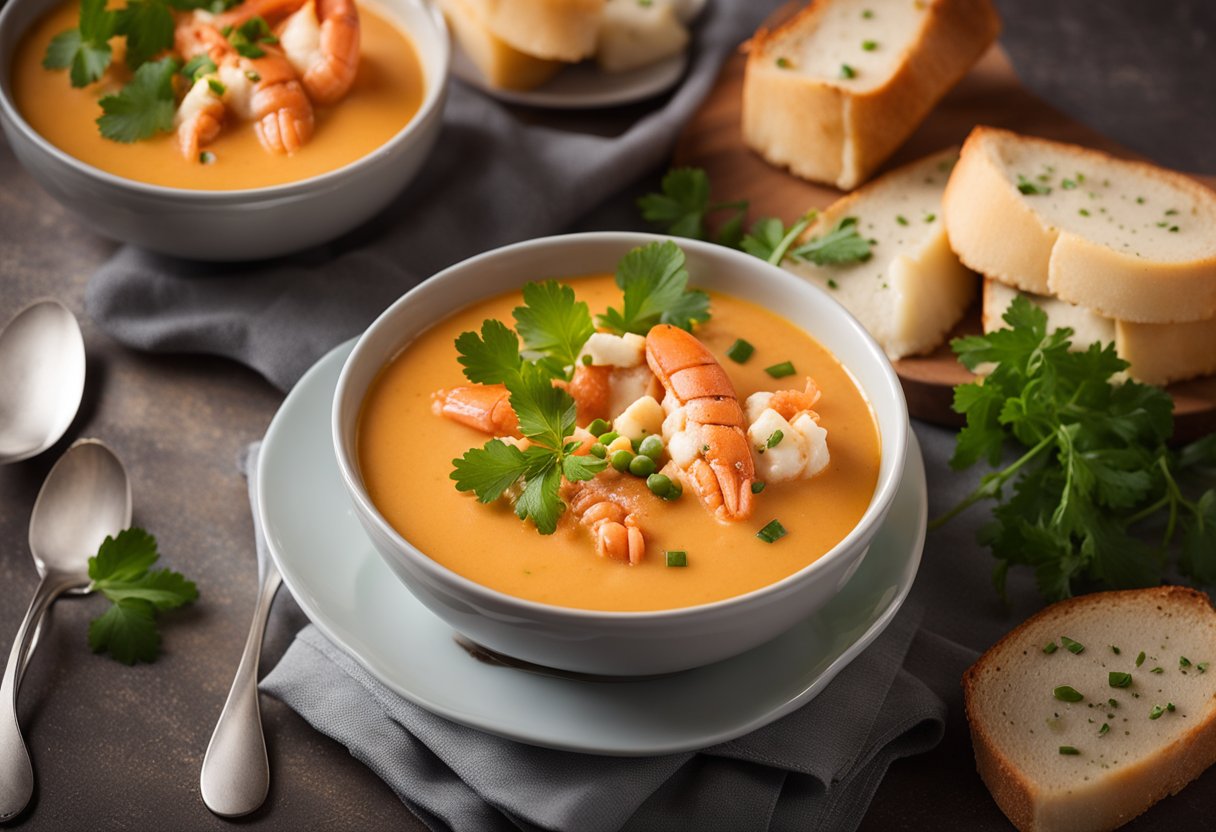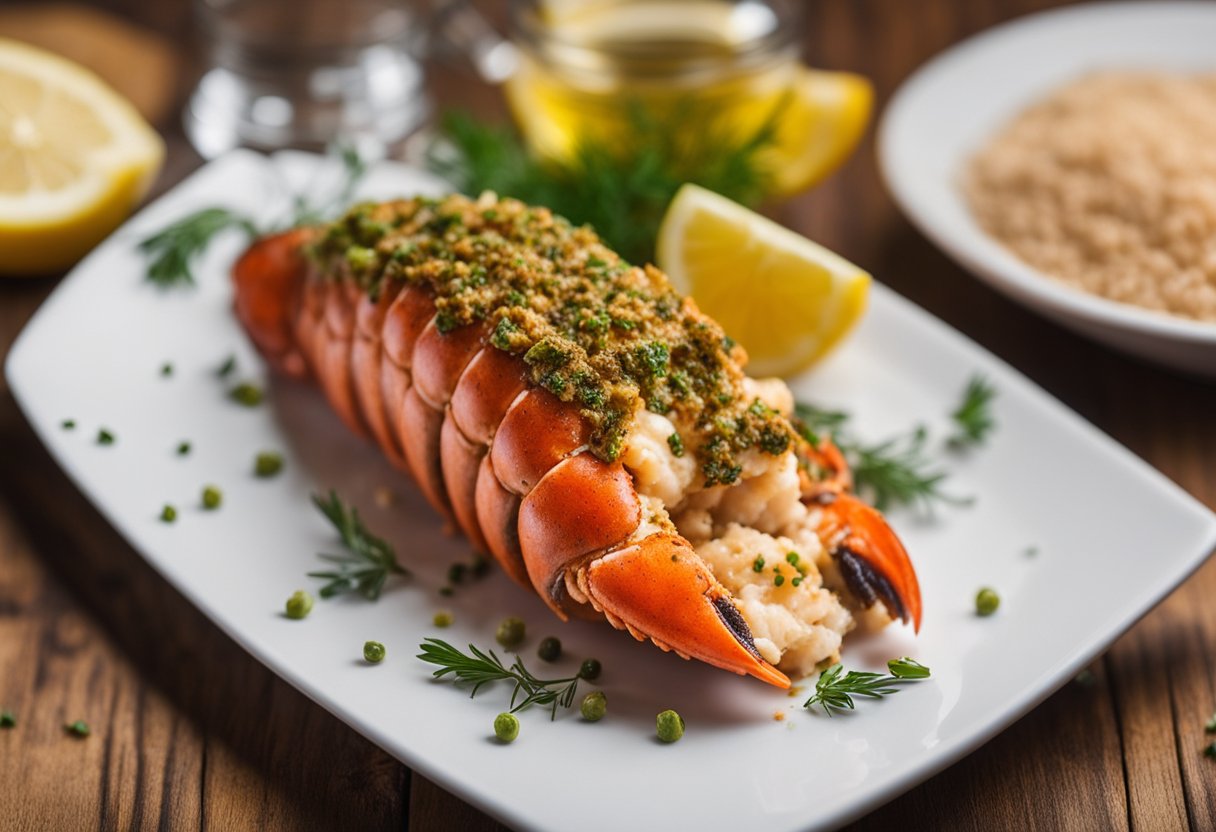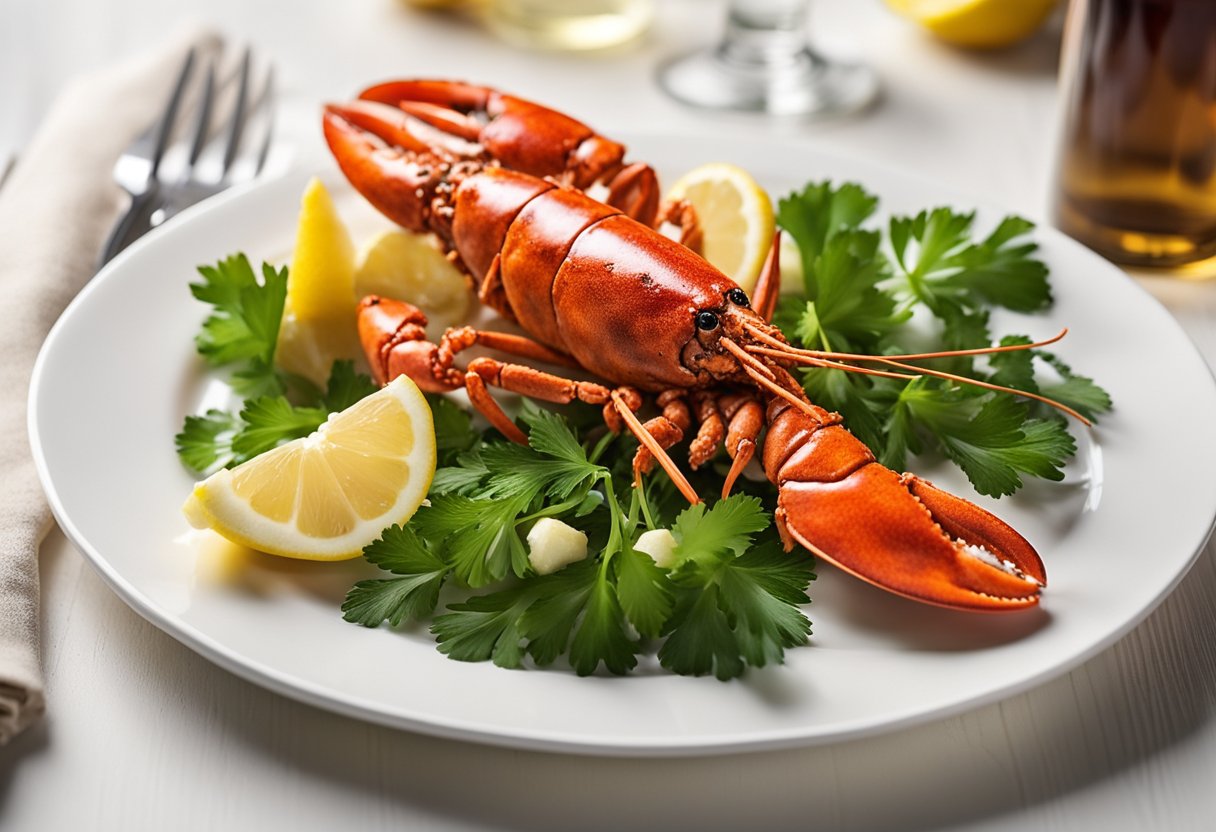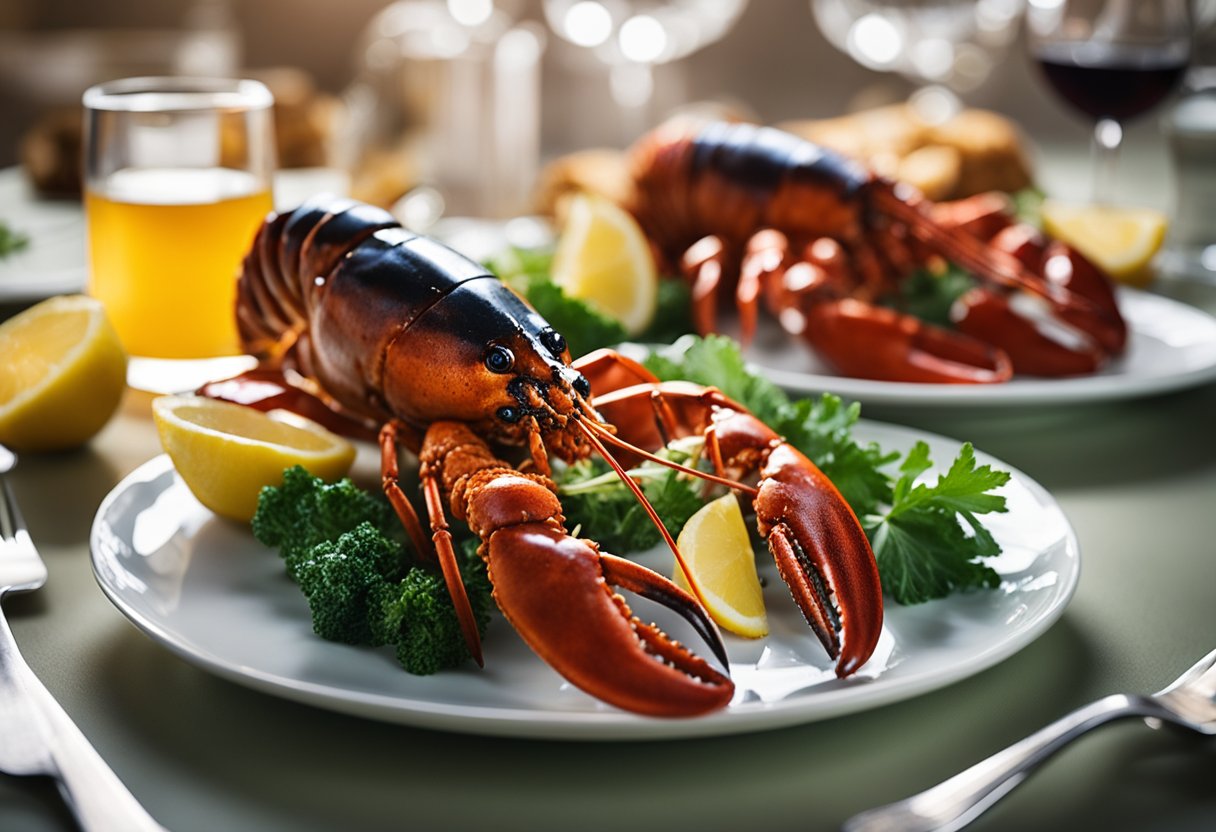I have always been curious about the taste of lobster. It is a popular seafood delicacy that is often associated with luxury and sophistication. Lobster is highly sought-after for its succulent and flavorful meat, which can be prepared in a variety of ways. But what does lobster taste like?

In general, the taste of lobster is sweet, rich, and slightly briny. The meat is tender and succulent, with a texture that falls somewhere between crab and shrimp.
The flavor can be enhanced with various seasonings and cooking techniques, making it a versatile ingredient in many dishes.
Key Takeaways
- Lobster has a sweet, rich, and slightly briny taste with a tender and succulent texture.
- The flavor of lobster can be enhanced with various seasonings and cooking techniques, making it a versatile ingredient in many dishes.
- Lobster is considered a delicacy due to its unique taste, texture, and association with luxury and sophistication.
What is Lobster
As a seafood lover, I find lobster to be one of the most delicious and sought-after shellfish. Lobster is a type of crustacean that belongs to the family Nephropidae. It is known for its succulent and flavorful meat that is often served as a delicacy in high-end restaurants.
Lobsters are found in all of the world’s oceans, but the most popular and well-known species is the Maine lobster, also known as the American lobster. This species is commonly found in the coastal waters of North America, particularly in the Gulf of Maine.
Lobsters have a hard exoskeleton that protects their soft, delicate bodies. They have ten legs, two of which are large claws that are used for defense and catching prey. Lobsters are omnivores and feed on a variety of small fish, mollusks, and crustaceans.
In terms of taste, lobster meat is sweet and tender, with a texture that falls somewhere between crab and shrimp. It has a melt-in-your-mouth consistency that makes it especially delightful, and it is often described as having a slightly salty, buttery taste.
It is important to note that not all lobsters taste exactly the same, as the taste can vary depending on the species and where it was caught.
Overall, lobster is a delicious and highly prized shellfish that is enjoyed by seafood lovers all over the world. Whether you prefer it boiled, grilled, or baked, lobster is a true delicacy that is sure to delight your taste buds.
Taste Profile of Lobster
As a seafood lover, I have tried many different types of seafood, including lobster. Lobster is a unique type of seafood that has a distinct flavor and texture. In this section, I will describe the taste profile of lobster.
Lobster has a sweet and delicate flavor that is unlike any other seafood. The sweetness of the lobster meat is balanced by a slight saltiness that gives it a savory taste.
The texture of the meat is also unique. It is tender and slightly chewy, with a melt-in-your-mouth consistency that is truly delightful.
One of the things that makes lobster stand out from other seafood is its unique flavor. Lobster has a sweet and buttery taste that is hard to describe. It is not fishy or overpowering, but rather has a subtle flavor that is both rich and delicate at the same time.
The sweetness of the lobster meat is due to its high content of glycogen, a type of sugar that is stored in the muscles of the lobster. This gives the meat a slightly sweet taste that is balanced by the natural saltiness of the sea.
In summary, the taste profile of lobster is sweet, delicate, and unique. It has a subtle flavor that is both rich and delicate at the same time, with a slight saltiness that gives it a savory taste.
The sweetness of the meat is due to its high content of glycogen, which gives it a slightly sweet taste that is balanced by the natural saltiness of the sea.
Texture of Lobster Meat
As a seafood lover, I find that the texture of lobster meat is one of the most unique and delightful aspects of this delicacy. The meat is soft, succulent, and has a melt-in-your-mouth consistency that makes it a favorite among many.
Lobster meat is firm, yet it has a spongier texture than other seafood, such as shrimp or crab. The texture can be described as slightly dry, and the shells have a coarse and rough feel with smooth patches.
When cooked to perfection, the texture of lobster meat is smooth and silky, with a slight chewiness that adds to its appeal. The meat is delicate and tender, making it easy to cut with a fork or knife.
It’s important to note that the texture of lobster meat can vary depending on the type of lobster and how it is prepared. Overcooking can make the meat tough and rubbery, while undercooking can leave it raw and unpleasant to eat.
In conclusion, the texture of lobster meat is a unique combination of softness, firmness, and sponginess. When cooked properly, it has a succulent and melt-in-your-mouth consistency that makes it a favorite among seafood lovers.
Comparing Lobster to Other Seafood
As a seafood lover, I have tasted various types of seafood, including crab, shrimp, shellfish, crawfish, and fish. When it comes to taste, lobster stands out from the rest.
Compared to crab, lobster has a more delicate flavor. It has a slightly sweet and buttery taste that is not overpowering. Crab, on the other hand, has a stronger taste that can be fishy at times.
Shrimp has a sweeter taste than lobster, but it lacks the rich flavor and texture of lobster meat. Shrimp is also smaller in size, which makes it less satisfying to eat.
Shellfish, such as clams and oysters, have a distinct taste that is different from lobster. They have a more briny taste and a chewy texture. Lobster, on the other hand, has a tender and succulent texture that is unmatched.
Crawfish has a similar taste and texture to lobster, but it is smaller in size and has a more pronounced fishy taste. Lobster, on the other hand, has a milder taste that is more refined.
When it comes to fish, there are some types of fish that have a similar taste to lobster. For example, cod has a mild flavor with hints of sweetness and a smooth and creamy texture that mimics the feel of a fresh lobster tail. Other fish that have a similar taste to lobster include monkfish, halibut, and sea bass.
In conclusion, while there are many types of seafood with unique tastes and textures, lobster stands out for its delicate, sweet, and buttery flavor. Its tender and succulent texture is unmatched, making it a favorite among seafood lovers.
Cooking Techniques and Their Impact on Taste
As a seafood lover, I have tried various cooking methods to prepare lobster. Each technique has its unique impact on the taste of the lobster. Here are some cooking techniques and their impact on the taste of lobster.
Steaming
Steaming is a popular method of cooking lobster. It is a gentle cooking method that retains the natural flavor and texture of the lobster. Steaming is also a healthy cooking method as it does not require any added fat. To steam lobster, place it in a steamer basket and steam for about 10-12 minutes.
Boiling
Boiling is another popular cooking method for lobster. Boiling is a quick and easy method of cooking lobster. However, boiling can result in overcooked or tough lobster if not done properly. To boil lobster, bring a large pot of salted water to a boil, add the lobster, and boil for about 8-10 minutes.
Grilling
Grilling is a great way to add smoky flavor to lobster. Grilling also gives the lobster a crispy texture. To grill lobster, brush it with butter or oil and grill for about 8-10 minutes.
Seasoning
Seasoning is an important aspect of cooking lobster. Lobster has a delicate flavor that can be easily overwhelmed by strong seasonings. A simple seasoning of salt, pepper, and butter is enough to enhance the natural flavor of the lobster.
In conclusion, the cooking method used to prepare lobster has a significant impact on its taste. Whether steaming, boiling, or grilling, each method has its unique impact on the flavor and texture of the lobster. A simple seasoning of salt, pepper, and butter is enough to enhance the natural flavor of the lobster.
Popular Lobster Dishes and Their Flavors

As one of the most sought-after seafood delicacies, lobster can be prepared in a variety of ways. Each cooking method brings out a unique flavor profile that makes it a favorite among seafood lovers. Here are some popular lobster dishes and their flavors:
Lobster Tail
Lobster tail is a classic dish that is often served as the main course in high-end restaurants. The meat is tender, succulent, and has a sweet, delicate flavor.
The tail can be grilled, broiled, or baked, and is often served with lemon butter or garlic butter sauce. The flavor of the lobster tail is enhanced by the smoky, charred taste that comes from grilling or broiling.
Lobster Bisque
Lobster bisque is a creamy soup made with lobster meat, cream, and spices. It has a rich, velvety texture and a deep, complex flavor.
The bisque is usually seasoned with herbs like thyme, bay leaf, and tarragon, which give it a slightly sweet and floral taste. The lobster meat adds a subtle briny flavor that balances the creamy base.
Lobster Thermidor
Lobster Thermidor is a French dish that consists of cooked lobster meat mixed with a creamy sauce made from egg yolks, butter, and white wine.
The sauce is flavored with mustard, tarragon, and cayenne pepper, which gives it a tangy and slightly spicy taste. The dish is then topped with grated cheese and broiled until golden brown, which adds a nutty and savory flavor to the dish.
Lobster Roll
A lobster roll is a sandwich made with a hot dog bun filled with lobster meat, mayonnaise, and spices. The meat is usually boiled or steamed and then mixed with mayonnaise, lemon juice, celery, and herbs like parsley and chives.
The roll has a sweet, briny taste that is balanced by the creamy and tangy flavor of the mayonnaise.
Lobster Recipes
Lobster can be used in a variety of recipes, from pasta dishes to salads. The meat is versatile and can be paired with a range of flavors, from spicy and tangy to sweet and savory.
Some popular lobster recipes include lobster mac and cheese, lobster risotto, and lobster salad. Each recipe brings out a unique flavor profile that highlights the sweetness and delicacy of the lobster meat.
In conclusion, lobster is a versatile seafood that can be prepared in a variety of ways, each bringing out a unique flavor profile. From the delicate sweetness of lobster tail to the tangy and spicy flavor of Lobster Thermidor, there is a lobster dish for every taste preference.
Seasoning and Enhancing Lobster Flavor

When it comes to lobster, many people prefer to keep it simple and let the natural sweetness of the meat shine through. However, there are plenty of ways to enhance the flavor of lobster with seasoning and other ingredients.
One classic way to serve lobster is with melted butter, which adds richness and a touch of saltiness to the sweet meat. For a twist on this classic, try making garlic butter by melting butter with minced garlic and a pinch of salt. This adds a subtle garlic flavor that complements the sweetness of the lobster.
Another way to add flavor to lobster is by using herbs and spices. Dill is a popular choice, with its lemony, sweet, and slightly bitter flavor profile. Other herbs that pair well with lobster include tarragon, parsley, and chives. For a little kick of heat, cayenne pepper can be added sparingly.
Cream and white wine sauces are also popular accompaniments to lobster. These sauces can add richness and depth of flavor to the dish. When making a cream sauce, be sure to use a light hand with the seasoning, as too much salt or other spices can overpower the delicate flavor of the lobster.
Garlic is another ingredient that can enhance the flavor of lobster. Roasting garlic and spreading it on the lobster meat can add a sweet, nutty flavor that complements the sweetness of the meat. Alternatively, sautéing minced garlic in butter and drizzling it over the lobster can add a savory note to the dish.
Ultimately, the key to seasoning and enhancing the flavor of lobster is to use a light hand with the seasoning and let the natural sweetness of the meat shine through.
Whether you prefer a classic butter sauce or something a little more adventurous, there are plenty of ways to enjoy the delicate flavor of lobster.
Factors Affecting Lobster Taste

As a seafood lover, I know that lobster is one of the most popular delicacies out there. But have you ever wondered what factors affect the taste of lobster? Here are some of the most important factors to consider:
Freshness
Freshness is the most important factor that affects the taste of lobster. Fresh lobsters have a sweet and delicate taste, while old lobsters taste fishy and bland. To ensure that you get the best taste, always buy live lobsters or fresh-frozen lobster tails.
Location and Season
The location and season in which the lobster is caught can also affect its taste. Lobsters caught in the cold waters of Maine, Canada, and Norway are considered to be the best because the cold water makes their meat tender and sweeter.
Lobsters caught during the peak season, which is from June to December, are also considered to be the best because they are more abundant and fresher.
Parts of the Lobster
The different parts of the lobster also affect the taste. The tail meat is the most tender and sweet part of the lobster, while the claws and legs are more fibrous and have a stronger flavor. The roe and tomalley, which are the eggs and liver of the lobster, respectively, also have a unique taste.
Fresh vs. Frozen
Fresh lobster is always the best, but frozen lobster tails can also be a good option if you can’t get fresh lobsters. However, frozen lobster tails have a slightly different texture and taste compared to fresh lobsters.
Price
Lobster is an expensive delicacy, and the price can also affect the taste. Some people believe that the more expensive the lobster, the better it tastes, but this is not always true. The taste of lobster depends on various factors, and the price is not always an indicator of quality.
Cold Water
Lobsters that are caught in cold water have a sweeter taste compared to those caught in warmer water. This is because the cold water prevents excess salt from entering the flesh, giving it a sweeter taste.
Overall, there are many factors that affect the taste of lobster. By considering the freshness, location and season, parts of the lobster, fresh vs. frozen, price, and cold water, you can ensure that you get the best-tasting lobster possible.
Why is Lobster Considered a Delicacy

As a seafood enthusiast, I have always been fascinated by the popularity of lobster in the culinary world. Lobster is a unique and expensive delicacy that is widely enjoyed by seafood lovers. In this section, I will explore why lobster is considered a delicacy and what makes it so special.
Expensive
One of the primary reasons why lobster is considered a delicacy is its high price tag. Lobster is one of the most expensive seafood items on the market, with prices ranging from $30 to $50 per pound.
The high cost of lobster is due to its limited supply and high demand. Lobster fishing is heavily regulated, and the process of catching and transporting live lobsters is both time-consuming and expensive.
Unique Taste and Consistency
Lobster meat has a unique taste and consistency that sets it apart from other seafood. The meat is juicy, flavorful, and has a melt-in-your-mouth texture that is hard to replicate.
The flavor of lobster is often described as sweet, with a hint of saltiness. The consistency of the meat is firm, yet tender, making it perfect for a wide range of dishes.
Nutrition and Protein
In addition to its unique taste and consistency, lobster is also a highly nutritious food. It is a great source of protein, with a 3-ounce serving containing approximately 20 grams of protein. Lobster is also low in fat and calories, making it a healthy seafood option.
Chefs’ Favorite
Lobster is a favorite of many chefs, who often use it as a centerpiece in their dishes. Chefs love lobster because of its versatility and the wide range of dishes it can be used in. Lobster can be boiled, grilled, baked, or fried, and can be used in soups, salads, sandwiches, and more.
Hard Shell and Demand
Another reason why lobster is considered a delicacy is its hard shell. The hard outer shell of the lobster makes it difficult to crack open and access the meat inside. This adds to the mystique and exclusivity of lobster, as it requires skill and effort to prepare and enjoy.
In conclusion, lobster is considered a delicacy because of its unique taste and consistency, high price tag, and limited availability. It is a highly nutritious food that is loved by chefs and seafood enthusiasts alike.
The hard shell of the lobster adds to its exclusivity and demand, making it a highly sought-after seafood item.
Frequently Asked Questions

How would you describe the taste of lobster?
Lobster has a unique and distinct flavor that is often described as sweet, succulent, and buttery. The meat is tender and delicate, with a slightly salty taste. The flavor of lobster can vary depending on the cooking method and the seasoning used.
What is lobster meat similar to?
Lobster meat is often compared to crab meat, but it has a sweeter and more delicate flavor. Some people also compare the texture of lobster meat to that of shrimp or scallops.
Does lobster taste like chicken?
No, lobster does not taste like chicken. It has a completely different flavor profile and texture. While chicken has a mild, savory taste, lobster is sweet and buttery.
Does lobster taste like crab?
Lobster and crab have similar textures, but their flavors are different. Lobster has a sweeter and more delicate taste, while crab has a slightly briny and more pronounced flavor.
Does lobster taste like salmon?
No, lobster does not taste like salmon. Salmon has a distinct flavor that is often described as rich and oily, while lobster has a sweet and delicate taste.
What does lobster smell like?
Fresh lobster should have a mild, oceanic smell. If the lobster has a strong, ammonia-like odor, it may not be fresh and should not be consumed.







